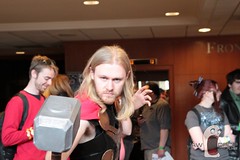
Scoliosis comes commonly in two forms "S" or "C" type curve patterns. "S" curves commonly referred to as duplicate majors have a curve in the thoracic spine and a curve in the lumbar spine which are similar in size. The typical pattern for an "S" curve scoliosis is a right thoracic and a left lumbar meaning the concave side in a left lumbar curve is to the right. This would look like an S from the front or a backward S from the back. "S" curves will typically demonstrate a posture presentation that is fairly centered on the midline when viewed from the front or back where their head, torso, and pelvis line up but their eyeline, shoulder line, and hip line will be tilted. The duplicate curve type will lead to two noticeable bumps that form as a "S" scoliosis progresses beyond 30 degrees. When a bending test is performed and the inpatient is viewed from behind while they bend down to touch their toes the interpreter will consideration a protrusion by the shoulder blade and a protrusion by in the lower back muscles.
This protrusion is due to the natural adaptation of the postural muscles to the scoliosis and is not causing the scoliosis. The smaller intrinsic or deep smaller muscles that connect each personel bone of the spine are influenced by the brain and the signal from the brain to the deeper smaller muscles is most likely the cause where these protruding muscles along the covering of the curvatures are secondary adaptations. So the brain tells the spine what position to be in and the posture muscle set the tone to stabilize this position as neutral. Since the spine becomes curved the muscles of posture on the covering of the curve will increase in mass,called hypertrophy, due to constant use for stabilization whereas the inside posture muscles will no longer be needed to stabilize the spine and will atrophy, decrease in mass, due to disuse. Think of the posture muscles as a light switch with a dimmer attached, the dimmer switch can be changed to whether allow more current or less current to the bulb manufacture it brighter or dimmer where the covering of the scoliosis curvature is given a lot of current and gets brighter (hypertrophy) and the inside of the curvature gets very diminutive current and is dim(atrophy). The larger the scoliosis becomes the more noticeable the variation in glow or muscle tone. It is not a case of weak or strong but rather how much current is being supplied due to need to remain carport in gravity.
Secondary adaptations to the "S" curve will involve disc wedge deformation and eventually bone wedge deformation. These secondary adaptations occur due to cellular remodeling. Direct pressure on the cartilaginous discs and the personel vertebrae will stimulate or inhibit increase creating an actual variation in the height of the disc or bone. Ribcage deformation will come to be noticeable with much larger curves in this type of pattern and will be somewhat diminutive due to the smaller size of thoracic curvature. The ribcage and personel ribs will also deform due to direct pressure since bone remodels based on its stress demands (Heuter- Volkmann principle) when ribs are located under immoderate pressure they will change shape. As the spinal column bends and rotates in the thoracic region this will then generate direct forces upon the ribs since they are attached to each personel thoracic vertebrae. The added the spine pushes laterally to the side the more forces will work on the whole cage adding to the ribcage deformation. If we go back to the bending test and consideration the two protrusions that appear in an "S" pattern scoliosis the protrusion in the thoracic region will eventually come to be structural deformation because of the ribs becoming bent. Since the lumbar spine does not have ribs attached the bulging protrusion in this region is diminutive to the muscle and remains purely soft tissue even in adulthood whereas the personel vertebrae regardless of location will come to be structural adaptation with time.
"C" curves are a bit misunderstood and can probably be defined differently depending on who you ask. "C" curves commonly refer to a scoliosis which has a particular major curve in the shape of the letter "C" in whether the thoracic spine or the lumbar spine. The real distinguishing factor in the middle of "S" pattern and "C" pattern scoliosis is whether or not the compensation curves cross the midline by at least half the length of the primary curve giving it the S shape. "C" curves commonly will demonstrate an awkward posture, meaning the patients neutral stance will appear like they are favoring one leg. "C" curves formed in the thoracic spine will demonstrate much larger ribcage deformity based on the sheer whole of thoracic vertebrae complex in this type of curve pattern. C type thoracic curves will have noticeable body disfigurement not precisely private by clothing especially in curves approaching 40 degrees or higher. The soft tissue adaptations are less prominent and commonly deeper due to the structural integrity of the ribcage compared to the lumbar spine where a "C" curve located in this region will demonstrate very large protruding muscle growth.
The ribcage deformity is not corrected by any form of bracing or scoliosis fusion surgery. The only way to reduce or eliminate the larger more angulated rib deformations is to accomplish a rib resection surgical operation where they shave it off like a side of beef. The moral of this story is that scoliosis is a very complex organized deformity that presents very young and if not attacked head on in the early stages of the game will lead to an broad whole of tissue adaptations that come to be irreversible. So waiting colse to for this process to unfold is obviously a bad decision.

0 comments:
Post a Comment